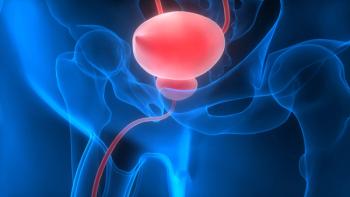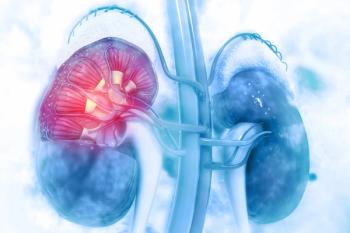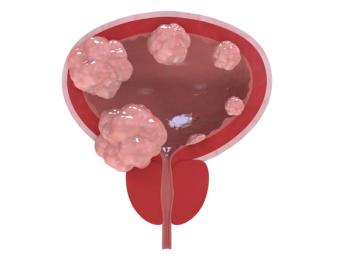
Axitinib/Pembrolizumab Safe, Active in Untreated Kidney Cancer
Combining axitinib and pembrolizumab is “safe and tolerable” among patients with previously untreated advanced renal cell carcinoma, with 73% of patients responding, according to findings from an open-label, phase Ib trial.
Combining axitinib and pembrolizumab is “safe and tolerable” among patients with previously untreated advanced renal cell carcinoma (RCC), with 73% of patients responding, according to findings from an ongoing open-label, phase Ib trial presented (
“The antitumor activity of the combination is superior to that expected from axitinib or PD-1/PD-L1 pathway inhibitor monotherapy,” said lead study author Michael B. Atkins, MD, of Georgetown Lombardi Comprehensive Cancer Center in Washington, DC.
Earlier studies had shown that combining programmed death 1 (PD-1) immune checkpoint inhibitors with vascular endothelial growth factor (VEGF) receptor tyrosine kinase inhibitors (TKIs) can be highly toxic, discouraging further development, Dr. Atkins noted.
“Many of these toxicities were related to off-target effects of these multi-targeted TKIs, suggesting that a more selective inhibitor of the VEGF pathway may be better tolerated,” said Dr. Atkins, “and produce synergistic antitumor activity.”
Axitinib targets VEGF receptors 1–3 and has been approved for second-line treatment of RCC. Pembrolizumab is a monoclonal antibody that inhibits interaction between PD-1 and its ligands, PD-L1 and PD-L2.
The study authors sought to test the hypothesis that axitinib and pembrolizumab represent an example of a synergistic antitumor combination therapy against previously untreated advanced RCC. The study consisted of a dose-finding phase to identify maximum tolerated dose and recommended dose for further study, and a dose-expansion phase.
Patients with advanced clear-cell RCC with resected primary tumor; more than one measurable, previously untreated lesion; an Eastern Cooperative Oncology Group performance status of 0 or 1; and without uncontrolled hypertension were enrolled in the study.
“Of the 11 patients treated during the dose-finding phase, three dose-limiting toxicities were reported: one patient had a transient ischemic attack and two patients were unable to complete at least 75% of planned axitinib dose due to treatment-related toxicity,” Dr. Atkins reported.
Treatment-related toxicities included grade 2/3 headache and grade 2 headache, fatigue, asthenia (abnormal weakness), and dehydration.
Fifty-two patients were enrolled in the dose-expansion phase of the study, including the 11 patients who had participated in the dose-finding phase.
As of a data cutoff date of March 31, 2017, 22 patients remained on axitinib and pembrolizumab. Eight had confirmed disease progression but remained on treatment.
The overall response rate (representing complete and partial responses) was 73%. Best overall response was complete response in 4 patients (7.7%), partial response in 34 patients (65.4%), and stable disease in 3 patients (5.8%). Median progression-free survival was 20.9 months overall and 22.1 months among patients with PD-L1–negative tumors.
The median duration of axitinib and pembrolizumab treatment was 14.5 months (range, 0.03–27.7 months).
Twenty-seven patients discontinued both axitinib and pembrolizumab, 10 because of adverse events, nine because of disease progression, and five because of a mixture of adverse events and disease progression. Three patients discontinued treatment for other reasons.
Axitinib dose was reduced for two or more consecutive doses to below 5 mg twice daily for 32 patients (61.5%). The median dose of axitinib was 8.8 mg daily, and the median pembrolizumab dose was 2 mg/kg per cycle.
The most common grade 3 or higher treatment-related adverse events included hypertension (23.1%), diarrhea and fatigue (9.6% each), and alanine aminotransferase increase (7.7%). Treatment-related aminotransferase increase was noted in two (3.8%) patients.
Fewer liver function test abnormalities and less fatigue were reported for the combination than other VEGF receptor TKI/PD-1 checkpoint inhibitor combinations, Dr. Atkins noted.
Of six deaths during the study, four were treatment-related.
“Whether the combination works better than a sequence of VEGF pathway inhibitor followed by an anti–PD-1 therapy awaits the completion of the phase III KN426 trial comparing axitinib/pembrolizumab vs sunitinib,” Dr. Atkins said.
The study was sponsored by Pfizer and Merck.
Newsletter
Stay up to date on recent advances in the multidisciplinary approach to cancer.
















































































